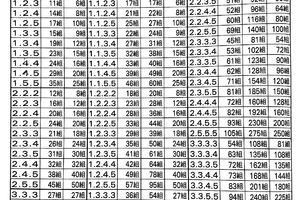江湖有云:「三分鐘韓語,三小時英語,三天的法語,三個月的日語,三年的德語,三百年的阿拉伯語!」到底最難的語言是什麼?今天小編就帶大家一探究竟。Many languages have been claimed to be the toughest one to learn. Here follow ten candidates for the title of "hardest language to learn," as released by the United Nations Educational Scientific and Cultural Organization. This list of 10 candidates includes an explanation as of why they made this list. Read it and find out whether these languages are worth their "tough as nails" reputation.
數種語言自稱為世上最難學的語言之一。下面就是競爭「最難學語言」的十門候選語,該名單由聯合國教科文組織發放。其中包括了入選排序的理由。閱讀該資料,看看這些語言是否真的像其名聲那樣讓人卻步。
 第十名:法語
第十名:法語
Top 10: French
As an official language in 29 countries, French is a challenging language. However, it can be seen as both easy and hard, depending on the learner's native language. French is a Roman language. If the learner's grasp of other Roman languages such as Italian, Portuguese and Spanish is strong, French will be a very quick and enjoyable new language to acquire.Otherwise, for those coming from a completely different language family, learning French would be considerably more difficult. Its pronunciation follows very strict rules based on the spelling, which is often based more on history than phonology.
作為29個國家的官方語言,法語具有足夠的挑戰性。然而,根據學習者不同的母語,它卻可簡單也可困難。如果學習者良好地掌握了羅馬語系的其他語言,如義大利語、葡萄牙語或西班牙語,那麼法語就會成為一門快速入門又能輕鬆掌握的語言。然而,對那些來自完全不搭邊的語言家庭的人,學法語就非常艱難了。法語的發音嚴格遵循其拼寫規則,相較於音韻學,它更多的是基於歷史。
第九名:丹麥語
Top 9: Danish
Danish is a North Germanic language spoken by some 6 million people.The sound system of Danish is in many ways unusual among the world's languages, which makes it one of the hardest languages in the world to learn, as the spoken language usually does not sound anything like its written version.
丹麥語出自北日耳曼語系,使用者約600萬人。丹麥語的發音系統廣泛,不同於世界上的其他語言,因為它拼讀的方式完全有別於書寫方式,這就使其成為了全球最難學的語言之一。
第八名:挪威語
Top 8: Norwegian
Norwegian is a North Germanic language spoken primarily in Norway,where it is the official language. It is among the world's languages that's the most difficult to learn how to speak well. No officially sanctioned standard of spoken Norwegian is in place and most Norwegians speak their own dialect at any given time.
出自被日耳曼語系的挪威語在挪威使用較廣,也是其官方語言。挪威語的口語是世界上最難學好的。它沒有官方認證的標準口語,在任何特定的時間挪威人都會說他們的方言。
第七名:德語
Top 7: German
As one of the world's major languages, German holds the largest number of native speakers within the European Union. It is a language which contains several standard dialects, both in its spoken and written forms. As an inflected language with three grammatical genders, it has a large number of words deriving from the same root.
作為世界上的主要語言之一,德語是歐盟使用者人數最龐大的語言。這門語言涵蓋了多種標準方言,無論是口語還是書面上。作為擁有三種語法範疇的有影響力的語言,德語大量的詞彙都出自於同一根源。
第六名:芬蘭語
Top 6: Finnish
As a language spoken by the majority of the population in Finland,Finnish is hard to learn for its extremely complicated grammar and"endless derivative suffixes." Finnish employ sex tensive modifiers to verbs, nouns, pronouns, adjectives and numerals, depending on their roles in the sentence.
作為芬蘭使用人數最多的語言,芬蘭語因其極複雜的語法和「無止境的衍生後綴」而成了難學語言。
第五名:日語
Top 5: Japanese
Japanese is an East Asian language spoken primarily in Japan. According to documents,Chinese had a considerable influence on the vocabulary and phonology of Old Japanese.Since 1945, it has borrowed a large number of words from English, especially vocabulary relating to technology. One major reason which makes the language so hard to learn is that the written code is different from the spoken code. In addition, Japanese has an extensive grammatical system to express politeness and formalities
日語是東亞語之一,主要使用地為日本。根據記錄,中文對舊式日語的詞彙和音韻有極其重要的影響。自從1945年起,日語就從英語中引入了大量詞彙,特別是科技領域。使日語難學的主要原因就是其書寫順序和拼讀順序不一致。此外,因其禮貌性和正式性,日語還具有相當廣泛的語法系統。
第四名:冰島語
Top 4: Icelandic
Icelandic, a North Germanic language, is the main language of Iceland.Icelandic is hard to learn because of its archaic vocabulary and complex grammar. Icelandic retains many grammatical features of other ancient Germanic languages, and modern Icelandic is still a heavily inflected language.
冰島語,北日耳曼語族語言,也是冰島主要語言。冰島語因其古老的詞彙和複雜的語法而難學。它具有古德語的多種語法特徵,現代的冰島語仍然是門有影響力的語言。
第三名:阿拉伯語
Top 3: Arabic
Arabic, belonging to the Afro-Asiatic language family, includes both the literary language and varieties of Arabic spoken across the Middle East, North Africa, and the Horn of Africa.The language has a complex and unusual method in constructing words from a basic root.For instance, nouns in Literary Arabic have three grammatical cases, three numbers, two genders and three "states."
阿拉伯語,屬於亞非語系語言家族,它包括中東、北非和非洲之角的文學語言和阿拉伯口語類。該語言根據詞根,通過複雜且特別的方式構詞。比如,在阿拉伯文學用語中,有三種語法格,三種數字,兩種性別和三種「時態。」
第二名:希臘語
Top 2: Greek
As an independent branch of the Indo-European family of languages, the Greek language features the longest and most documented history. It is spoken mainly across Greece and Cyprus. Along its history, its syllabic structure has remained constant. It has a mixed syllable structure,allowing for relatively complex combinations of sounds. In addition,Greek possesses an extensive set of productive derivational affixes and a rich inflectional system.
混合的音節結構,也讓發音組合變得相對複雜。此外,希臘語擁有一體化的生產派生詞綴和豐富的曲折詞綴系統。
第一名:中文
Top 1: Chinese
Chinese forms one of the branches of the Sino-Tibetan language family and over one billion people can name it as their native language. The relationship between the spoken and written Chinese language is rather complex. Its written form has no clues as to how it is actually pronounced. The tone system also is a pain because there are many homo phones in Chinese only distinguishable by the four tones. Even this is often not enough unless the actual context and exact phrase are identified.
中文是漢藏語系的一個分支,乃10多億人的母語。中文拼讀和書寫間的關聯甚是複雜。僅看字體根本無法知道如何發其音。語音系統也是一大障礙,因為中文有太多的同音字,又僅靠四個聲調來區分。然這遠遠是不夠的,除非實際的上下文和相應的短語已經足夠明確。
看完是不是突然覺得會一口流利中文的自己特別niubility!
反正小編我覺得自己可以飛上天和太陽肩並肩了!



























